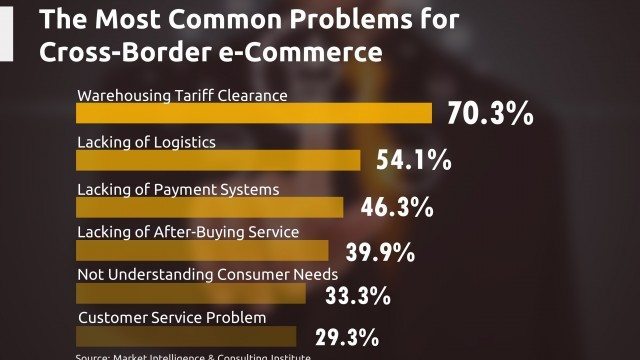Indonesian consumers are really cautious when it comes to providing credit card information and having shipping costs online

According to a questionnaire survey by Market Intelligence & Consulting Institute in Taiwan (MIC), in connection with the problem faced while operating cross-border e-commerce, statistics show that obstacles within the top ranks such as, normal payment or logistics problems, information flow problem including customer profile analysis and after-sales service, and so on.
Thanks to the agreement on cross-border payments formed through alliance by several traditional financial business including VISA, Master, and the P2P payment tools including PayPal, Alipay Global; Those classical conditions are no longer set limitations to cross-border e-commerce industry.
But there’s still some tough bottleneck exist.

Data Source: Market Intelligence & Consulting Institute/Graphic made by the author (JiunYi Yang)
Let’s focus on information flow problems. Do cross-border e-commerce truly understand what local customer needs? How will they behave on their mobile devices? Why over 90 per cent of users drop out the store page before they ordered anything?
How can cross-border e-commerce grasp the local customer profile without having an expedition to Southeast Asia? The main solution must be “digital advertising.”
Also Read: The future of on-demand payments for Indonesia’s ridesharing companies
Statistics from IAB (Interactive Advertising Bureau) show that “online advertisement with Ad tech” has already exceeded “television commercial” and become the biggest single media worldwide which intensely changing customer behaviour.
To support brilliant eCommerce companies better penetrate different markets in each SEA countries, here consolidate key points of customer behaviour from several survey report, and present as Info-graphic to easily understand. We first pick Indonesia for deep observation and summary.
(Indonesian) customer behaviour: Mobile usage

Data Source: Report from GfK & Google/Graphic made by the author (JiunYi Yang)
According to survey result from GfK and Google, we can strongly feel the “Mobile Only” phenomenon happening in Indonesia. With 61 per cent usership of smartphone, comparing to 17 per cent usership of PC, strongly advise that eCommerce who are aiming to penetrate Indonesia marketplace, “First Mobile” online experience design absolutely plays a necessary role.

- Data Source: JAKPAT Mobile Apps and GfK reports/Graphic made by the author (JiunYi Yang)
Then how about customer behaviour on devices?
Statistics show that Indonesians spends an average of 5.5 hours per day on mobile, and the using peak happens at noon and evening. So your marketing campaign can publish both at noon and evening before 30 minutes, in order to expose your service or product to enough potential audiences.
Also Read: M-commerce platform Sale Stock launches LINE partnership, AR-based “changing rooms”
Furthermore, the top three frequent activities on mobile are social networking, searching, and gaming. One of survey on JakPat Mobile Apps indicate that, 85.32 per cent users will have social networking at least once each day on mobile. By the way, Facebook owns the highest access(72.96 per cent) as usual in Indonesia.
So considering how to engage in customers social networking activities to having more word of mouth, enhance search engine optimisation for official websites, and seamless integrate entertaining elements with your service or product to make consumers interested and perhaps, share or purchase it.
(Indonesian) customer behaviour: Online shopping physically and mentally observation

Data Source: Nielsen Global Survey of E-Commerce, Q1 2014/Graphic made by the author (JiunYi Yang)
In the following infographic, let’s zoom in to “online shopping behaviour”, which eCommerce Industry care the most. As you can see, travel services are the most commonly purchased items online in Indonesia. So Indonesians might also have more purchase intentions when browsing travel accessories.

Data Source: Nielsen Global Survey of E-Commerce, Q1 2014/Graphic made by the author (JiunYi Yang)
After taking a look at external influences, how mentally factors deeper affecting customer behaviour. Indonesia digital consumers enjoy going online to shop especially when it comes to read online reviews and product research, as a means of checking out products to inform their offline purchases.
Therefore, make sure your brand provides seamless online-to-offline experiences, in order to convert more royal customers.
Also Read: Welcoming the future of work: Indonesia’s XWORK rides on the wave of mobile working trend
On the other hand, Indonesian consumers are really cautious when it comes to providing credit card information and having shipping costs online. Appropriate customer service may turn the tables to win loyalty and trusts from them.
To summarise, understanding local customers has been more and more important in recent years. As smartphone widely popularise to Southeast Asia, eCommerce definitely can’t miss “Mobile First” thinking.
In the modern age where information explodes every minute, the one who can accurately grasp what consumers thinks & needs, expose brand messages to the right people at the precise timing, revenue is in the bag.
–
All graphics made by the author JiunYi Yang
The views expressed here are of the author’s, and e27 may not necessarily subscribe to them. e27 invites members from Asia’s tech industry and startup community to share their honest opinions and expert knowledge with our readers. If you are interested in sharing your point of view, submit your post here .
The post Knowing your customer well is the key to success: Indonesian mobile behaviour appeared first on e27.